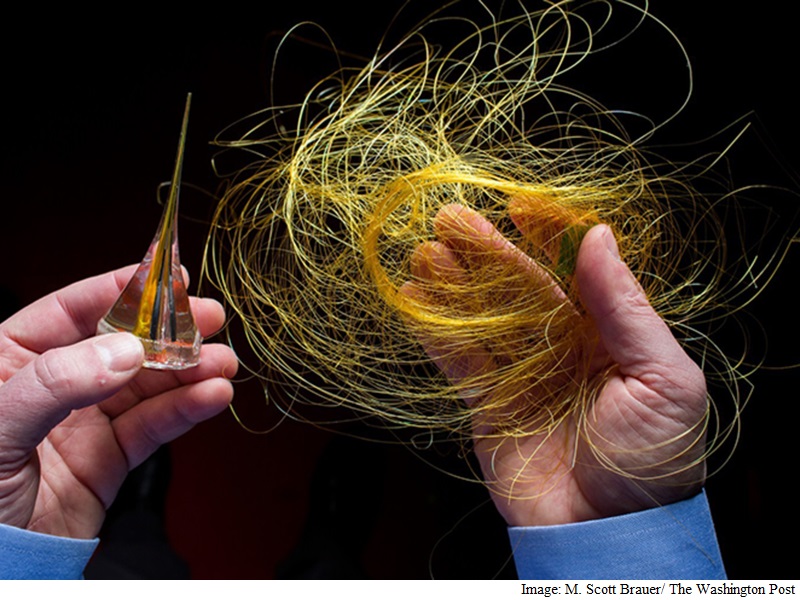- Home
- Wearables
- Wearables Features
- Time to Change a Diaper or Car Tire? Futuristic Fabrics Will Let You Know
Time to Change a Diaper or Car Tire? Futuristic Fabrics Will Let You Know

"It's really giving for the first time since the beginning of history fabrics a new meaning," Fink said. "This stuff is hanging on you, but what value are you deriving from it?"
Fink envisions clothing made of fabrics that track a person's health and help medical professionals provide better care. One day Fink said we'll select clothing not only for how it looks, but what it can do for us. Fabrics that store energy could provide climate control, helping a person endure extremely hot or cold conditions. Sheets on a bed could provide the perfect temperature and monitor our sleep cycles.
This is the latest example of attempts to bring technology to our attire. Nike has patented a sneaker with an activity tracker built in so that information can be shared with a smartphone app. UnderArmour has shown a strong interest in next-generation fabrics that track fitness data. But so far these efforts haven't delivered a hit product with such technology, offering a reminder that futuristic fabrics still have a lot of room for development.
Eventually Fink thinks such next-generation fabrics will be everywhere fabrics are from plane wings to tires and diapers. Such fabrics could trigger a notification when a tire or diaper needs changing.
While the tech industry talks of "wearable" devices such as smartwatches, next-generation fabrics would literally create wearable computing devices that hang in our closets. What looks like a typical shirt might actually have some of the abilities of your smartphone or smartwatch.
One of those involved in the initiative is Drexel professor Genevieve Dion, who brings a background in fashion and industrial design. She thinks better fibers may allow someone with a medical condition to carry on with their life more easily. For example, a stroke patient could wear what looks like a typical glove that would help them move and grip things without trouble.
"If I can wear it and be a part of the world and don't need to draw attention to myself because I'm wearing a weird device, it allows me to carry on and be a productive member of the society," Dion said.
Fink acknowledged such clothing items would be more expensive than traditional fibers. But he envisions clothing that would be subsidized by companies willing to offer a discount in exchange for receiving data the fabrics collect.
The nonprofit institute, which will be based in Cambridge, Mass., will involve universities, start-up incubators and companies around the country. It's called the Advanced Functional Fibers of America Institute, and it has won a government competition for funding. Of the partnership's $317 million (roughly Rs. 2,107 crores) in funding - coming from companies, investors, universities and some US states - $75 million (roughly Rs. 498 crores) will come from the Defense Department. Ashton Carter, the secretary of defense, announced the news Friday morning at MIT.
Military applications could include uniforms that are harder for enemies to see, or that help service members distinguish friend from foe while looking through certain eyewear. Eric Spackey, the institute's interim chief operating officer, pointed to a graphene antenna his company Bluewater Defense is building into military backpacks as an early indication of what futuristic fabrics have to offer.
© 2016 The Washington Post
Get your daily dose of tech news, reviews, and insights, in under 80 characters on Gadgets 360 Turbo. Connect with fellow tech lovers on our Forum. Follow us on X, Facebook, WhatsApp, Threads and Google News for instant updates. Catch all the action on our YouTube channel.
Related Stories
- Samsung Galaxy Unpacked 2025
- ChatGPT
- Redmi Note 14 Pro+
- iPhone 16
- Apple Vision Pro
- Oneplus 12
- OnePlus Nord CE 3 Lite 5G
- iPhone 13
- Xiaomi 14 Pro
- Oppo Find N3
- Tecno Spark Go (2023)
- Realme V30
- Best Phones Under 25000
- Samsung Galaxy S24 Series
- Cryptocurrency
- iQoo 12
- Samsung Galaxy S24 Ultra
- Giottus
- Samsung Galaxy Z Flip 5
- Apple 'Scary Fast'
- Housefull 5
- GoPro Hero 12 Black Review
- Invincible Season 2
- JioGlass
- HD Ready TV
- Laptop Under 50000
- Smartwatch Under 10000
- Latest Mobile Phones
- Compare Phones
- OnePlus 15R
- Realme Narzo 90x 5G
- Realme Narzo 90 5G
- Vivo S50 Pro Mini
- Vivo S50
- OPPO Reno 15c
- Redmi Note 15 5G
- Redmi Note 15 Pro 5G
- Asus ProArt P16
- MacBook Pro 14-inch (M5, 2025)
- OnePlus Pad Go 2
- Poco Pad M1
- Just Corseca Skywatch Pro
- Honor Watch X5
- Acerpure Nitro Z Series 100-inch QLED TV
- Samsung 43 Inch LED Ultra HD (4K) Smart TV (UA43UE81AFULXL)
- Asus ROG Ally
- Nintendo Switch Lite
- Haier 1.6 Ton 5 Star Inverter Split AC (HSU19G-MZAID5BN-INV)
- Haier 1.6 Ton 5 Star Inverter Split AC (HSU19G-MZAIM5BN-INV)

















